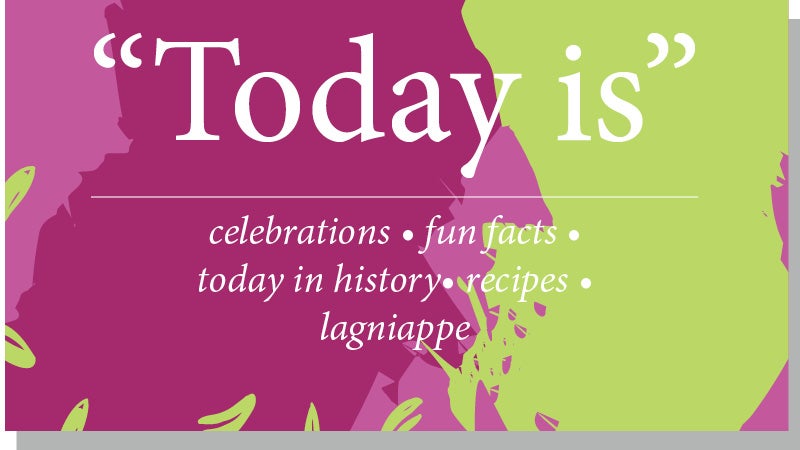Today is April 29
Published 8:00 am Thursday, April 29, 2021
|
Getting your Trinity Audio player ready...
|
Dance Day
The origins of line dancing
When attending a country hoedown, one is bound to encounter line dancing. Line dancing is popular in honkey tonks, bars, church basements, and just about anywhere folks are gathering for a good time.
The history of line dancing is extensive, though there is debate as to its origins. According to the Grizzly Rose club in Colorado, some believe that country line dancing can be traced back to the round and square dances of Europe. Others say it originated with 19th century social settlement movement folk dancing. Settlers of towns had their own songs and sounds that evolved into modern country music. In turn, dances were modified to go along with the tunes. Contra dancing, which is a form of American folk dance in which the dancers form two parallel lines and perform a sequence of dance movements with different partners down the length of the line, likely played a hand in the evolution of country line dancing as well.
As its name suggests, line dancing involves people dancing in lines to music. The dances are choreographed with a repeating series of steps that are performed in unison. Dancers all face the same direction, although there may be multiple lines. Dance Poise also says that there is almost no physical contact between dancers, unlike other country western dances, though hand-holding may occur.
Country line dances are made up of various steps to a number of counts, which coordinate to the beat. They often feature catchy names, such as “The Texas Two-Step,” “The West Coast Shuffle” and the “Boot Scootin’ Boogie.”
Some find line dancing so appealing because it does not require a partner, making it ideal for singles, couples or those who feel they aren’t the strongest dancers.
Line dances are not limited to country music. Popular music has given rise to many different line dances, including the “Charlie Brown,” the “Macarena” and the “Cha-Cha Slide,” among others.
Line dancing can make for an entertaining night out with friends who share a love of country music.
**
In 1968, the musical “Hair” opened at the Biltmore Theater in New York.
**
Hair-raising information about roller coasters
A trip to the amusement park wouldn’t be complete without a ride or two or three on a roller coaster. As businesses slowly begin to reopen after COVID-19 social distancing closures, theme parks may once again begin to welcome the public back for thrills and chills. In the meantime, future thrill-seekers can build up their bravery in anticipation. While you wait for amusement park gates to reopen, read up on these roller coaster facts.
Roller coasters are designed to give a person a seemingly close brush with danger through speed and hair-raising drops and flips. The Roller Coaster database indicates there are currently more than 2,500 roller coasters in the world. The first roller coasters were not the thrill-inducers found today at parks. The Switchback Gravity Railway, for example, which was a patented coaster that visitors to Brooklyn’s Coney Island could ride in 1884, faced riders outward. This was so they could enjoy a fabricated landscape scene while coasting at less than six miles per hour.
Many of the thrills associated with roller coasters are due to drops and dips from various heights. According to How it Works, changes in gravitational forces explain why the body, particularly the stomach, feels weird when riding a coaster. =
“When in freefall, every part of you is accelerating at the same rate, which gives you a similar feeling to weightlessness,” says Damien Arness-Dalton, from Science Museum. “There is no upwards force from the ground to cause your organs to be compressed, so they are floating inside of you, even though you are falling.”
This is new territory for the human body, so mixed signals are sent to the brain, indicating something is awry.
Gravitational forces affect how roller coasters are designed, too. Many extreme coasters have vertical loops. Roller coasters are teardrop-shaped instead of circular because, if they were circular, riders would be subjected to a force of 6-g on the body. That could cause blackouts, according to Gizmodo. The inverted teardrop shape helps to counter these high forces on the body.
Of course, speed and spins are not the only things that draw thrill seekers to roller coasters. Those who like the feeling of being in the clouds also enjoy reaching new heights. While many coasters inch riders up a steep incline gradually, “Kingda Ka” at Six Flags amusement park in New Jersey goes from zero to 128 miles per hour in only 3.5 seconds to speed riders up the rails 45 stories high at a 90-degree angle. At 456 feet in height, it’s the tallest coaster in the world.
Roller coasters are here to stay. When amusement parks reopen, chances are the lines to enjoy some hair-raising fun will be long.






